Socializing a cat means helping the animal to become well-adjusted and comfortable in social situations involving other animals and humans. The process involves exposing the cat to many stimuli, experiences, and interactions to help the animal become more confident and less fearful of new situations.
Socialization is especially important for cats that have had negative experiences or very limited human contact, such as strays, feral cats, and those that have been mistreated previously.
A well-socialized cat will be better behaved, less aggressive, more trusting, and easier to train and handle, increasing the chances of finding a loving forever home.
The benefits of socializing a cat are as endless as a ball of yarn! A well-socialized kitty is confident, happy, and less likely to turn your curtains into their personal scratching post. Plus, they’re more likely to be the star at your next get-together!
So, are you ready to help your kitty strut their social stuff? Keep reading as we reveal all the tricks and tips to turn your feline friend into a social butterfly!
What is Socialization for Cats?
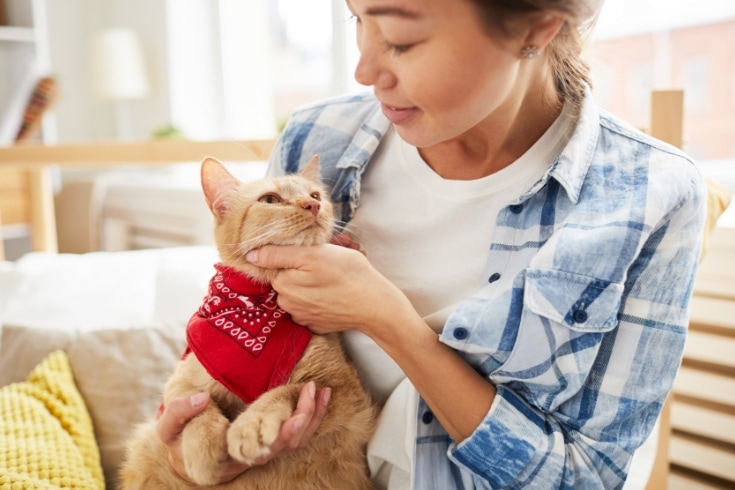
Socialization for cats means exposing the cat to as many experiences, interactions, and situations as possible to help the animal increase in confidence.
Socialization is important if a cat has had negative past experiences or limited human contact. A well-socialized cat will be more trusting, less prone to aggression, and easier to train and handle, making it much more pleasant to have around your home.
How Did Cats Become Domesticated?
It’s thought that cats first became domesticated around 4,000 to 9,000 years ago in countries such as Egypt, Iraq, and Turkey.
Domestic cats are descended from wildcats, most likely the African wildcat, and probably started to associate with people in early agricultural communities. The cats were probably attracted to the rodents feeding on spilled and stored crops.
Gradually, humans realized that having these wildcats around was a great way of keeping down rodent populations and protecting valuable grain stores, and the cats benefited from a ready food supply. Of course, non-aggressive, friendlier cats were most likely to be welcomed by humans, so domestication gradually took place.
In Ancient Egypt, cats were revered and incorporated into religious practices that saw mummified cats accompanying important society members on their journey to the afterlife. Felines feature strongly in artworks of the time, and it was considered a serious offense to harm or kill a cat.
Over centuries, cats spread from Egypt worldwide with explorers and traders, helping control vermin onboard ships and new settlements. Eventually, domestic cats became widespread, evolving into different breeds through selective breeding.
What Is The Difference Between Domesticated And Socialized Cats?
Domestication refers to a process that’s taken place over many generations of cats, leading to their overall adaptation to co-existing in harmony with humans.
In contrast, socialization refers to a cat’s early life experiences that teach the cat to be comfortable around humans and living in their environment.
So, essentially, cats can be both socialized and domesticated.
What Is The Difference Between “Feral” Vs. “Stray” Vs. “Pet” Cats?
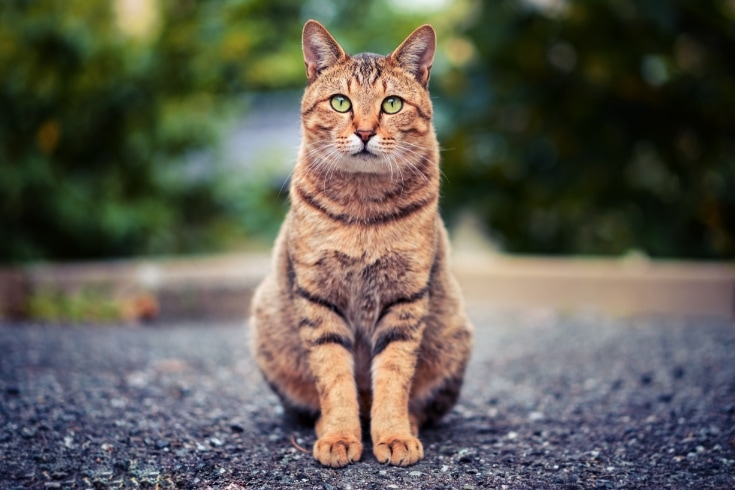
Feral cats are domestic cats that have returned to a wild state or have been born and raised without human socialization.
These cats are typically afraid of human contact and avoid it, preferring to live outdoor, self-sufficient lives, often in colonies. These cats can be extremely aggressive when approached and are commonly found living around stable and farmyards where there are plenty of rodents as a food source.
The two cats I have currently came to me as kittens born to a feral female cat. Both are friendly, happy little souls, although one is considerably more skittish than the other and keeps well away from people. Perhaps she has inherited a little of her mom’s feral nature?
Stray cats are usually domestic cats that were once pets but have ended up living rough, having been lost or abandoned. These cats might once have been socialized and often seek food and shelter for humans, although they can be skittish and cautious of human contact.
Over the years, I’ve owned several former stray cats that have come to me from rescues, and all have been incredibly friendly, loving, contented kitties after a brief settling-in period.
Pet cats are domesticated cats that are happy to live alongside humans in a companionship role. These cats are well-socialized, forming strong bonds with their human owners, and receive regular care, such as veterinary attention, food, water, and shelter.
What Are Signs Of Socialization?
The signs of socialization include:
- Vocalization (meowing, chirping, etc.)
- Willingness to approach people
- Allowing people to touch
- Walking toward you with tail raised
- Rubbing against your hand or legs
- Reaching out to you
- Maintaining a relaxed posture
Socialized cats are also open to being trained and can learn simple, basic commands.
Socialized Cat Behaviors
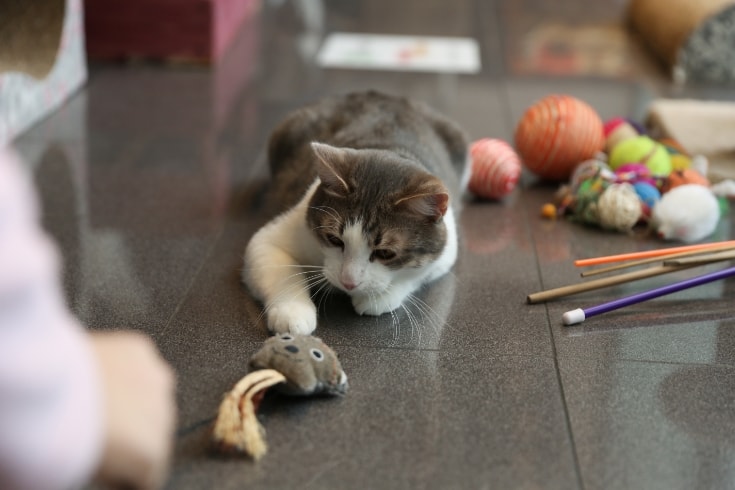
As outlined above, a socialized cat will allow you to touch her, she will approach you with her tail raised in greeting, rub against your legs or hand, reach toward you to be petted, meow, and “talk” to you.
Socialized cats also enjoy playing with interactive toys like laser pens and feather wands.
Unsocialized Cat Behaviors
In contrast, unsocialized cats will shy away from human contact, refusing to approach, and might growl or hiss.
What Are Factors Affecting Socialization In Cats?
Age
Early socialization is essential for cats since kittens and young cats are generally more receptive to new situations than older ones.
Breed
Some cat breeds are naturally friendlier than others, making them easier to socialize.
Positive, Neutral, Or Negative Interaction
Cats that experience positive or neutral interactions with humans and other animals are easier to socialize than those that have negative experiences.
Environment And Stress Level
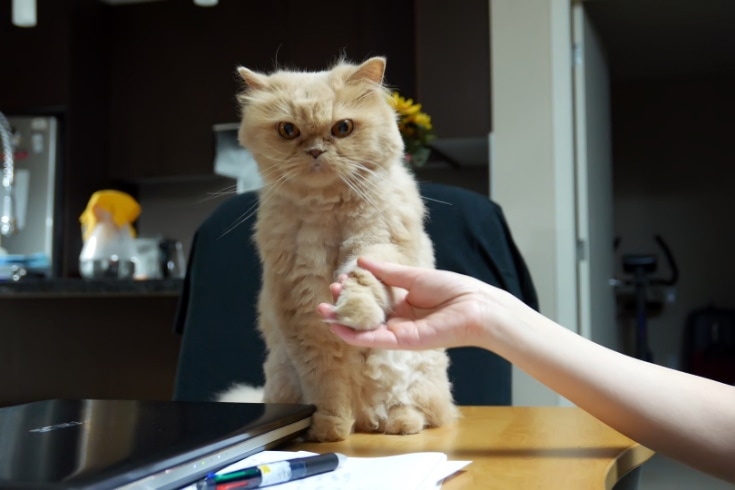
A calm, quiet environment is the best situation for socializing cats and lends itself to a more relaxed, stress-free experience.
Health
A healthy cat is less likely to be frightened or shy and therefore is easier to socialize than one that’s in discomfort.
Personality
All cats are individuals with unique personalities. Some cats are naturally more friendly and outgoing than others, making them easier to socialize.
Previous Experiences
Cats that have experienced neglect, abuse, and trauma can be aggressive or shy toward humans, making them harder to socialize.
Early Socialization
Kittens that are socialized between 2 and 7 weeks of age are more likely to become well-socialized adult cats.
Fear And Anxiety
A cat that’s afraid of people will take much longer to become socialized and trusting.
Other Pets
Sometimes, it can be easier to socialize a cat if you have another cat that’s already used to spending time around people.
Time And Patience
As with any form of training, socializing a cat takes time and patience and is not a process that can be rushed.
Training Methods
When socializing your cat, always use positive reinforcement methods, including plenty of rewards and praise for the best results.
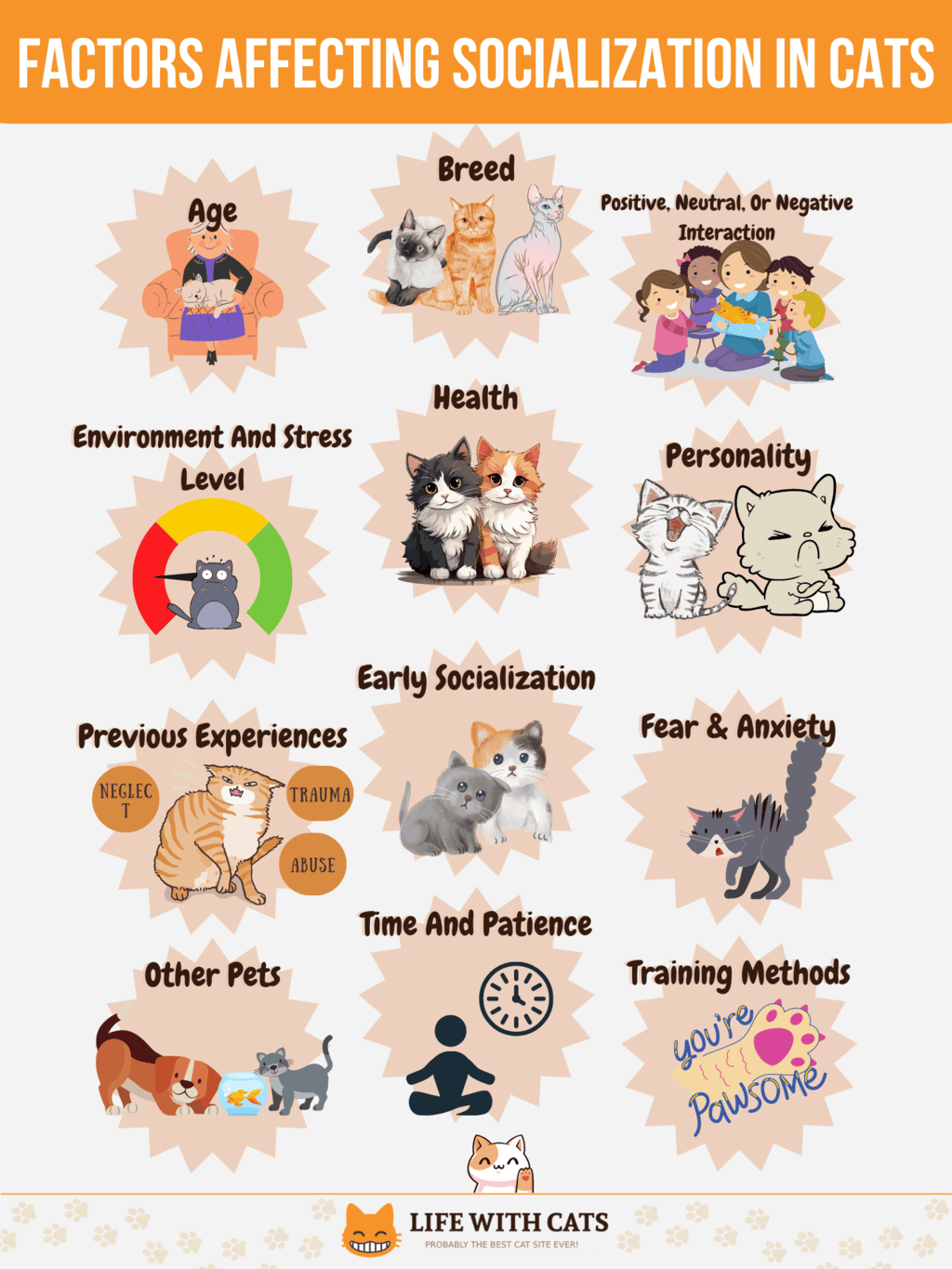
What Are Pre-Socialization Steps In Socialization Training In Cats?
The pre-socialization steps in socialization training in cats include:
Health Checkup
Before you begin the socialization process, have your cat’s health checked by a vet.
Safe Environment
Create a comfortable, safe environment for the cat to live in so that stress and fear are kept to a minimum.
Familiarization
Take time to allow the cat to become familiar with you and her new environment so she doesn’t feel stressed and anxious.
Building Trust
Talk gently to your cat and provide plenty of positive experiences for her to build her trust in people.
Pheromones
Use pheromone products to keep your cat calm and relaxed during socialization.
Observe Behavior
Observe your cat’s behavior to understand when she is feeling more comfortable around humans and identify times when you can get close to her without her feeling afraid or threatened.
Slow Introduction
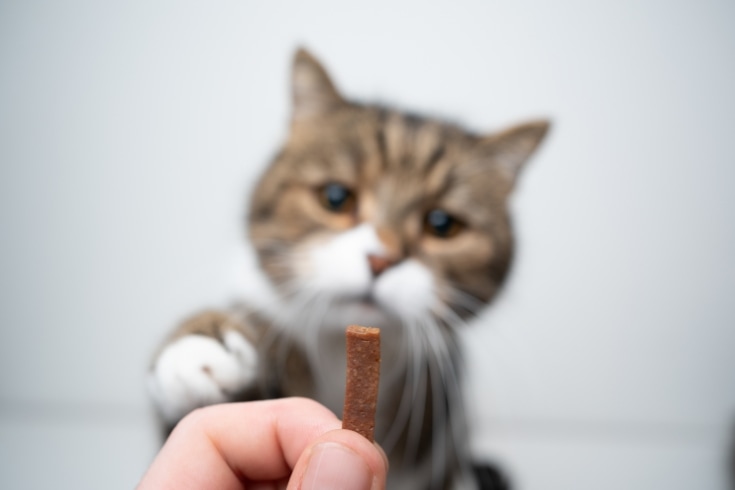
When socializing stray or feral cats, take your time and don’t try to rush things. I find it’s always better to proceed at the cat’s pace rather than your own!
Establish A Routine
Cats are creatures of habit and do best when given a regular routine. That way, the cat knows when she is going to be fed, groomed, enjoy playtime, and settle down to enjoy a relaxing nap.
Use Of Treats
Many cats enjoy tasty treats, and using these as a reward for desirable behavior can be an extremely important tool in socialization.
Play Sessions
During socialization, play sessions are extremely important for kittens and young cats because they teach the cat that interaction with humans and other pets can be fun.
How To Socialize Your Cats
The approach you take to socializing your cat varies, depending on what you want to achieve.
How To Socialize Your Cats With People
One of the most important aspects of socializing your cat is teaching her how to behave around people.
One-On-One Meetings
Rather than overwhelming your cat by introducing him to lots of people, keep early encounters on a one-to-one basis.
Group Introductions
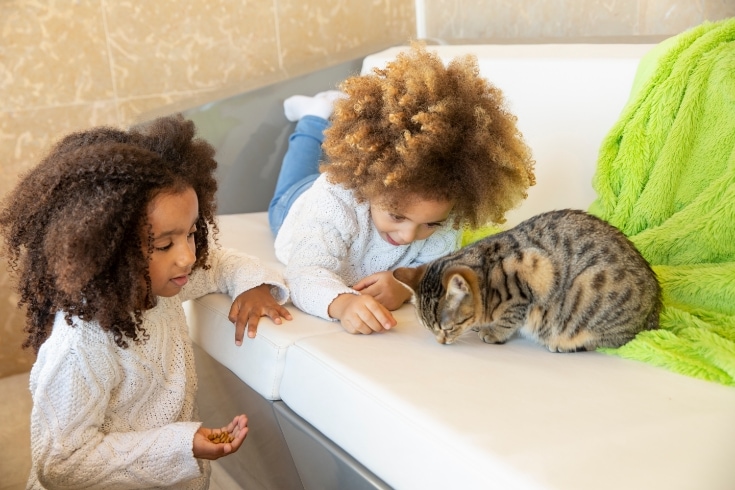
Once your cat is happy and relaxed around you, try introducing more people into the group.
Interactions With Children
Kids can frighten a nervous cat by grabbing at her and trying to pick her up, so you must carefully manage your cat’s interactions with children.
How To Socialize Your Cats With Other Cats
Step-By-Step Introduction
To avoid placing a strange can in a confrontational situation, make introductions slow and step-by-step, only moving on when both cats are totally relaxed and comfortable around each other.
Dealing With Territory Issues
Cats can be very territorial, so you need to observe your cat for signs of aggression. It can take some time for a new cat to be accepted in the same home as an existing one, so be prepared to create a separate area for the new cats to live in until territorial issues have been sorted out between the two.
Establishing A Peaceful Coexistence
You can help establish a peaceful coexistence between multiple cats by paying them equal attention and not favoring one over the other.
How To Socialize Your Cats With Dogs Or Other Pets
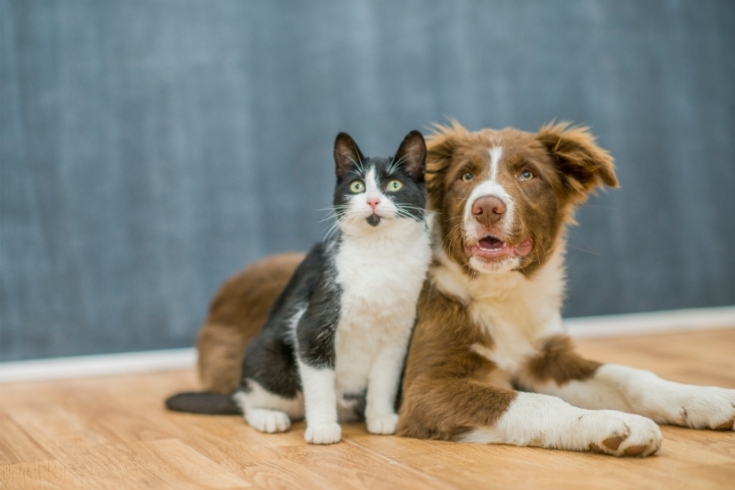
Initial Meeting
Manage your cat’s initial meetings with dogs and other pets very carefully. Putting one pet in a crate can work well so the other can sniff without chasing or swatting.
Supervised Interactions
Always supervise any interactions between your cats, and be prepared to intervene if there are signs of aggression.
Building A Harmonious Relationship
Use positive reinforcement techniques to build and establish a harmonious relationship between you and your cat. If you are taking on a stray or feral cat, you must be patient and accept that socializing the cats will most likely be a long process.
How To Expose Your Cats To New And Different Environments
Part of the socialization process for cats involves exposing them to new and different environments. That way, the cat gets used to being around different people and stimuli in a controlled, safe way.
Indoor Exploration
Your cat will probably be spending quite a lot of time indoors, depending on where you live and whether she is going to be a house cat or not.
Allow your cat to check out your home and explore her new environment. Before you give your cat the run of the house, make sure she knows where the litter box is and that there are no areas where she could get into trouble.
Leash Training For Outdoor Exposure
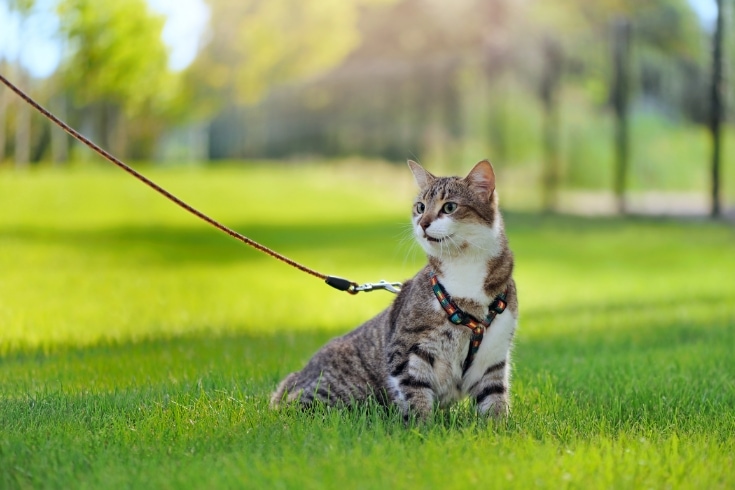
Using a harness and leash is a great way of allowing your cat to explore your backyard without risking her escaping. That is extremely important if you are rehoming a stray or feral cat or if you are taking on a high-value cat.
Car Rides And Vet Visits
At some point, your cat will need to ride in your car, for example, on vet visits. Always use a high-quality cat carrier to transport your cat, and take the time at home to get your cat used to going in the carrier before you take a road trip.
How To Maintain Social Skills In Cats
An essential part of the socialization process is learning how to maintain your cat’s social skills, and there are several ways in which you can do that.
Regular Social Interactions
You have taken the time to teach your cat how to behave socially around other people and animals, so you need to keep that going by exposing your cats to regular social interactions with other people and animals.
That way, your cat learns that being around many different people is perfectly normal, and she will come to no harm.
Continued Exposure To Different Situations
In the same way, you must expose your cat to as many different situations and stimuli as possible.
For example, you could buy your cat a new toy and perhaps invite a friend your pet hasn’t met before around for an interactive play session.
Positive Reinforcement
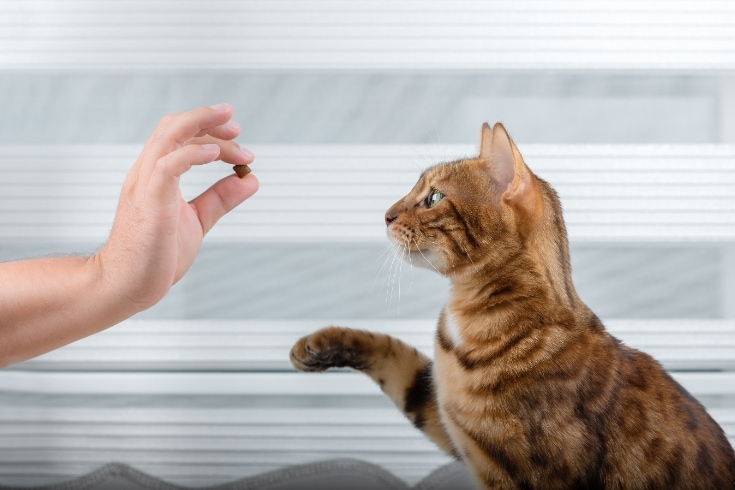
Positive reinforcement refers to a training technique involving rewarding your cat when she responds correctly to a training command or social situation. The idea is that cats are more likely to repeat a behavior that’s followed by a positive outcome or a reward.
For positive reinforcement to work, you need to reward the cat immediately after she has done something good or behaved in a particular way. That ensures the cat quickly understands that good behavior will earn her a tasty treat, petting, playtime, praise, or any other stimuli that your pet enjoys.
Positive reinforcement is essential when socializing your cat, as it focuses on rewarding desirable behavior rather than frightening or punishing the cat for unwanted behavior. That helps to create a positive, trusting relationship between you and your feline friend while encouraging your pet to display the desired behaviors willingly.
FAQs
Here are the answers to some of your most frequently asked questions about socializing your cat.
Is It Too Late To Socialize My Cat?
It’s never too late to socialize your cat! However, young cats and kittens are much easier to socialize and train than older cats.
What Happens If You Don’t Socialize Your Cat?
If you don’t socialize your cat, she might become anxious and fearful in new and unfamiliar situations, resulting in aggressive or defensive behaviors. Cats that lack socialization often struggle to adapt and cope with changes and new situations, can develop behavioral issues, and struggle to enjoy a good quality of life.
How Long Does It Take To Socialize Cats
The time it takes to socialize a cat depends on many factors, including the cat’s age, personality, and previous life experiences. So, some cats and kittens take a few weeks to socialize, whereas others can take months.
How Long Are Cats OK Alone?
Cats are independent creatures that can generally be left alone all day, provided they have access to food, water, and shelter. Indoor cats need a clean litterbox, too.
Is It Too Late To Get My Cat A Friend?
Younger cats are typically more accepting of a new companion than older ones, but that all depends on how well-socialized your cat is and on her individual personality.
Can You Socialize An Older Cat With Other Cats?
You can socialize an older cat with other cats, but I advise that you do so under supervision and be prepared to intervene and remove the cat if she becomes aggressive or anxious.
How Do You Socialize An Indoor Cat?
Indoor cats don’t have the same exposure to stimuli as outdoor ones, so the socialization process is somewhat easier.
You can use toys, videos, and visits from your friends and family to help introduce your cat to new people and situations, and sometimes, providing your pet with access to a windowsill to sit on can provide her with outside stimuli.
How Do You Socialize A Scared Cat?
If your cat is scared, it’s essential that you allow plenty of time to socialize her. Don’t push forward too quickly; be patient and prepared to take things at your cat’s pace.
How Do You Socialize A Shy Cat?
A shy cat can be socialized by using the same techniques you’d use for a scared cat. Take your time, and don’t try to force the cat to accept situations and stimuli she finds stressful.
How Do You Socialize An Antisocial Cat?
Not all cats like people; some are simply happier when left alone. That doesn’t mean your cat can’t be socialized and trained to behave in a good way around people and other pets; you sometimes just have to accept that you don’t own a cuddly cat.
I once took on an elderly rescue cat that hated being petted and was much happier being left to her own devices. That said, she was litter trained and well-behaved around the house and enjoyed a comfortable, stress-free life until she eventually passed away of old age.
Are Indoor Cats Happy Alone
All the indoor cats I’ve owned were happy to live alone. In fact, some cats are less social than others and prefer their owner’s company rather than that of another pet.
That said, you should always provide your cat with plenty of toys to play with and take time out each day to train, groom, and pet her.
In Conclusion
A well-socialized cat is a pleasure to have around your home as a companion. Although you can socialize a cat at any age, it’s best to begin socializing cats from kittenhood, exposing them to as many sights and sounds as possible. That means the cat will be more confident and less afraid in new situations.
Socialization is essential for cats that have had limited human contact or negative experiences and those with a chequered past of abuse and mistreatment, such as feral cats and strays,
Have you ever taken on a feral cat? How did you socialize her? Tell us about your feline friend in the comments box below!